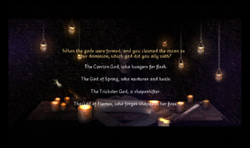Seven Dragon Saga Kickstarter Update #12: Paul Murray on the Turn-Based Combat System
Seven Dragon Saga Kickstarter Update #12: Paul Murray on the Turn-Based Combat System
Game News - posted by Infinitron on Sun 22 March 2015, 23:24:58
Tags: Paul Murray; Seven Dragon Saga; Tactical Simulations InteractiveIn this weekend's Seven Dragon Saga Kickstarter update, Paul Murray describes the nitty-gritty implementation details of the game's turn-based combat system. It's a compromise between classic action points and modern "move and attack"-type systems. I quote:
A lot of combat in games involves what you allow the characters to do each turn. There are various ways to restrict this: from the simple, “one move, one attack”, to the action points systems where everything has a cost. In Seven Dragon Saga we chose a flexible middle ground. One move, one attack, provides minimal choice for the player, while an action point system tends to favor a more static battle -- most players choose to use points to attack as often as possible, sacrificing movement.
Each turn, the character has three actions of differing size: Unique (most attacks), Standard (most movements), and Minor (quick spells and abilities). The player may substitute a smaller action for a bigger one, so a Turn could consist of two Standards and a Minor, or three Minors.
So how’s this work in detail? Spellcasting is limited to one spell per turn, so one could cast a buff spell (Standard), draw a weapon (Minor) and attack with it (Unique). Or a meleer could gut an enemy in front of him (Unique), move up to the next enemy (Standard), and mark it with a Leadership debuff (Minor). A Shadowmaster character could turn invisible (Minor), shoot an opponent with surprise (Unique) and return to invisibility (Minor).
Movements come in two forms: conventional, Running, Evasion and Mystic Leap, which use Standard actions; and fast, Flash Step and Teleport, which use Minor actions. Each provides its own tactical advantages and disadvantages. Using Flash Step, a character could move out from cover, shoot, and move back into cover in the same turn. Evasion and Leap take up the Standard action, but avoid any Opportunity Attacks. Running is the overall fastest movement.
In addition, there are limited use abilities which provide extra actions. Adrenaline gives an additional Unique, and that always desirable extra attack or spell. Mobility provides an added Standard, for more movement, or just another useful action. Quickness nets an extra Minor action.
All of this provides the player great tactical choice, while giving the game strong control over damage per turn from players and enemies. Maintaining this balance allows us to design interesting battles with an expectation of their overall duration and challenge. No one wants a fight that is both a foregone conclusion and drags things out.
Sounds pretty cool. Not sure about the names of the action size categories, though.Each turn, the character has three actions of differing size: Unique (most attacks), Standard (most movements), and Minor (quick spells and abilities). The player may substitute a smaller action for a bigger one, so a Turn could consist of two Standards and a Minor, or three Minors.
So how’s this work in detail? Spellcasting is limited to one spell per turn, so one could cast a buff spell (Standard), draw a weapon (Minor) and attack with it (Unique). Or a meleer could gut an enemy in front of him (Unique), move up to the next enemy (Standard), and mark it with a Leadership debuff (Minor). A Shadowmaster character could turn invisible (Minor), shoot an opponent with surprise (Unique) and return to invisibility (Minor).
Movements come in two forms: conventional, Running, Evasion and Mystic Leap, which use Standard actions; and fast, Flash Step and Teleport, which use Minor actions. Each provides its own tactical advantages and disadvantages. Using Flash Step, a character could move out from cover, shoot, and move back into cover in the same turn. Evasion and Leap take up the Standard action, but avoid any Opportunity Attacks. Running is the overall fastest movement.
In addition, there are limited use abilities which provide extra actions. Adrenaline gives an additional Unique, and that always desirable extra attack or spell. Mobility provides an added Standard, for more movement, or just another useful action. Quickness nets an extra Minor action.
All of this provides the player great tactical choice, while giving the game strong control over damage per turn from players and enemies. Maintaining this balance allows us to design interesting battles with an expectation of their overall duration and challenge. No one wants a fight that is both a foregone conclusion and drags things out.














